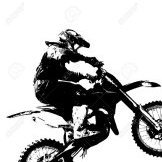-
Posts
1,550 -
Joined
-
Last visited
Contact Information
-
The mouth of the reed block can be carefully opened out by about 3mm possibly more ( its been a fair while since I have done this mod so choose your dimensions carefully) this allows a significant improvement to air flow into the intake port. Boysen Reeds are best as they don’t tend to wreck the engine if they break off…unlike the spring steel originals. Always bent the reed stop plates when fitting Boysens by about 4mm never ran without the stop plates. This mod we did to TY’s LC 2/350’s and RD 400. Take great care of the stop plate fixing screws you don’t want them getting inside the motor. Do any of these mods at your own risk.
-
The TY 250 was notorious for having a strangled induction (too many twists etc). So the best way forwards was to improve the induction route to smooth the passage of air to the intake port. Some riders said at the time that the engine was too responsive when modified and needed taming down. Now a days it might be too tame!
-
Don’t forget to support the bike before you do anything to the forks.
-
Sounds as though you have a bike that was at some time owned by a knowledgable rider, hence the mods you have found. When I needed new cases I spoke with In Motion who supplied me with some s/h items that were nigh on perfect. If you have any cracks and get them welded be sure to check internal clearance as weld penetration can interfere with the flywheel and lock the crank when the case is tightened. As the forks from what I can see are not rusty where the sliders travel over and it is the exposed area between the yokes, try cleaning with wire wool or careful use of 600/1200 wet and dry with light oil. Not an ideal fix but that lets you get on with restoration/rebuild. If you use Ethanol free Aspen or similar then you will not need to worry about lining any fuel tank, plastic is better than glass reinforced plastic or fibre glass if you will. The plastic tank will take a few knocks if you use the bike in anger, again talk to In Motion who can advise you accordingly. Keep us updated on your progress.
-
Your suggestion that the ignition coil may be breaking down sounds about 99% correct, its that 1% that can catch you out. When the engine was rebuilt do you know if that included an electrics ( ignition check), however a check on the coil when cold might not show any fault. With the engine bursting into life when cold and running for some time and then stopping does point to the coil.
-
Oh dear, and only 17 posts and its looking decidedly problematical.
-
Well as its the Dad thats wanting a lighter bike, go with his enthusiasm for a lightweight Bantam. With all those years of riding experience it would be his decision what to ride. Everyone is making suggestions for different machines but let the main man make the decision, that way he will be happier than being cajoled onto a bike he doesn’t want! You could of course try and get his current bike into a better state of maintenance.
-
You can purchase non ethanol fuel ie Aspen fairly locally, I use a mower dealer in Forrest Town...that gets rid of the stale/plastic distorting...eating...gelling up pump fuel issue. Probably why your carb jets are clogged up! Just because you say you have limited mechanical skills shouldn’t prevent you from sorting your Fantic, you may need all the skills you can muster if you are going to ride trials and practice, especially if you break down in the middle of no where. By getting to know your bike will increase confidence. With those jets don’t be afraid to probe them with a suitable tool eg wire or as you have used pins just don’t remove any metal and increase the jet size. If it runs on the main jet its more than likely the slow running jet(s). Maybe save some money and try just buying new correct size jets before lashing out on a new carb. The Fantic 200 is a really nice machine (156cc) and is an ideal first bike which will be suitable as a keeper. The electronic ignition if original may be suffering some degradation and would be worth checking all connections for corrosion and fit. There is masses of info on this website and plenty of knowledgeable individuals to get help and advice from. Out of interest did you get the Fantic from a dealer or private? As an extra it would be worth checking the fuel tap/tank filter for dirt etc.👍
-

Sherpa 199A Brake Hub Steel Liner Fitting Clearance
section swept replied to midgy's topic in Bultaco
Your hubs may split or crack even at the correct interference fit due to the aluminium becoming age degraded...more brittle. Presumably the hub will be heated to expand the housing and the liner shoved in a freezer to shrink slightly. Using this method the liner should just slide into the housing and be allowed to cool naturally. Some people have used a resin bonding agent whilst others have employed locking screws or locking pins, although these methods may increase the fragility of the hub(s). There is info on this web site if you do a search you should find it. More importantly is that you know the inside diameter of what the brake drum should be, I would have thought. Your engineer is obviously being wary and quite rightly so. As to interference clearances and taking into consideration heat build up when braking...you would need to brake for a very long time to build up significant heat in a Bultaco brake shoe assembly front or back. Here are some details for you. The housing is bored out to accept the sleeve, read that as cleaned up. When the sleeve is installed into the aluminium housing, the interference fit is .004. When the sleeve is being installed into a cast iron housing, the interference fit is .002 to .003. The interference fit is determined by measuring the outside diameter of the sleeve, then boring the cylinder diameter smaller than the sleeve. In this case you do not want to remove much if any material from the hub. The lining needs to be in effect .004 oversize to the hub. Any areas of corrosion in the hub could be treated with a resin adhesive suitable for metal. The interference fit is a critical aspect of sleeve installation because this step ensures that the sleeve does not move when in the hub. Now you have this info I do not accept any liability for the process if you decide to employ any of the suggested methods and it all ends in damage. -

Can someone help me identify this BSA
section swept replied to Tomsmokes93's topic in Classic Trials
Looks like a collection of BSA parts put together to form a bike. Well worth restoring once you have decided on the bikes designation eg road bike proper, trials or trail. I believe Triumph used the BSA 250 bike as a sort of pseudo trail bike model. Research carefully and maybe have a look at the Otter website. You may well have a 250 Star which would have been near the end of the production life of the smaller engined bikes. That full width front hub suggests road together with the 18/19 inch rim. What ever you have the basis of a potential good and interesting restoration project...wish I had it! Good luck with what ever path you decide to follow. -
When you look at the arc that the kickstart travels through (say from 12 o’clock) by the time the kick start lever has met the footrest any further rotation would be lost effort it just feels as though you are achieving greater leverage by ‘kicking through’ so to speak. You can compare this action to tightening a nut or bolt, once you reach 90 degrees thats the maximum effective leverage unless you are superman. As Woody states, with the bike set up correctly (engine wise) it should burst into life at the second or third prod if not the first. All of my Bultacos kicked into life with relative ease thats 325, 350, 250 all on contact breakers, all had kick starts that met the footrest. Yes you get issues when you drop the bike but all things being equal they restart once you calm down and ensure everything is as it should be.
-
Just had a quick look at Google, typing in BSA C15 Trials gearing. You should find plenty of helpful info and probably sort a good starting compromise to fine tune the overall rear wheel sprocket and gearbox sprocket size (no of teeth). A lot will depend on the internal ratios of the gearbox, you might find that with lower overall gearing the engine will work fine in first and second, but third and fourth might be a bit too low for any road work or distance between sections. Something else to bear in mind is the torque effect of a drive chain being pulled around the smaller output gearbox sprocket which can have/cause adverse wear issues. Then you may also have chain to frame/ swing arm clearance problems. Some negatives but not un solvable! You might consider going the whole hog and fitting C15 T internals (if some can be sourced) from the visible effort that you are putting in it will be worth it. Waiting to see the finished article...good luck with your bike?
-
?The Bultaco engine ignition timing if set too close to tdc there could be an instance of reverse running. This can happen if the kickstart is lazily prodded. For contact breaker systems initial setting at 3.00mm would be a good starting point, listen out for detonation on accelerating in say third gear up a slight incline. You may end up with a final setting at 2.75mm, this is measured piston travel coming up to tdc best measured with either a dti (dial test indicator) or vernier caliper, either can be positioned through the spark plug hole but turn the engine over very slowly so you don’t catch the measuring device with piston. Hope you are successful?
-
You can of course use Auto-trans fluid in the clutch as this is produced to work in all metal and high heat clutch packs. Less tendency for sticking too!
-
Your frame appears to be different in that the area next to the steering head looks to be opened out as does the frame near the footrests...optical effect of photo or painted in black...does look like it has the stampings removed.




